Biography
Interests
Josep Mercadal1* & Carles Pérez2
1IUSM Fundacio Vidal i Barraquer, Barcelona, Spain
2FPCEE Blanquerna, Universidat Ramon Llull, Barcelona, Spain
*Correspondence to: Dr. Josep Mercadal, IUSM Fundacio Vidal i Barraquer, Barcelona, Spain.
Copyright © 2019 Dr. Josep Mercadal, et al. This is an open access article distributed under the Creative Commons Attribution License, which permits unrestricted use, distribution, and reproduction in any medium, provided the original work is properly cited.
Abstract
This study focused on the variables physical attractiveness, infidelity and jealousy with the goal of studying whether there was a relationship between people with higher physical attractiveness scores and lower jealousy scores and a more favourable attitude towards infidelity. To accomplish this, we had a sample of 87 subjects (34 men and 53 women). We found that there was no relationship between jealousy and infidelity, but there was a relationship between physical attractiveness and infidelity, in that those with higher scores on physical attractiveness were significantly more unfaithful.
We also sought to relate sexual freedom and physical attractiveness and found that the score on physical attractiveness influenced the desire to live in a sexually freer society where promiscuity was not stigmatised.
Finally, we found that the higher the score on physical attractiveness the greater the tendency to repress oneself from being unfaithful due to social pressure.
Introduction
In Europe as a whole, infidelity in young adults (aged 18-23) has a prevalence of 23.3% in men and 19.2%
in women [1]. This figure is increased when checking the prevalence of infidelity within marriage: Tagler and
Jeffers (2013) [2] claim that that between 30% and 50% of marriages have experienced infidelity in some
form. This means that half the population has been unfaithful at least once. Despite this, infidelity is still a
taboo in our society.
Numerous studies have been published that show different kinds of infidelity, such as infidelity with strong emotional ties but no sexual bonds, sexual infidelity without emotional ties, and acts of infidelity with both sexual and affective bonds [3]. Other studies show significant differences between men and women regarding infidelity: while men prefer to be the victims of emotional infidelity, women prefer sexual infidelity [4,5]. Some authors distinguish between benign and malign infidelity, the former meaning the kind that strengthens the couple and the latter the kind that destroys it [6,7]. Many variables that predict infidelity have been studied, but we are aware of no studies that focus on physical attractiveness. Pérez (2006) [8] claims that the likelihood of being unfaithful depends on the number of occasions the person has to be so. Therefore, the physical component would appear to play a key role. Brase, Adair and Monk (2014) [9] claim that the feeling of inferiority experienced by the victim of infidelity is aggravated if the third person is regarded as not professionally, personally and physically valued. That is, it is more acceptable from the social standpoint for a partner to be unfaithful with a more highly-valued person, while a fling with an undesirable person is taken as a major insult and threatens self-esteem. The same authors argue that social pressure is one of the most important dampers on infidelity, and indeed we live in a society that is highly marked by religious beliefs, where sexual freedom and variety are taboo and the cause of criticism, even though may people perversely engage in them, hidden away from criticism yet adding to the criticism when someone else is unfaithful.
Buss and Shackerford (1997) [10] believe that infidelity has existed in all cultures and all eras, and that it has been the leading cause of divorce and marital abuse. The same holds true with jealousy; Maturana (1997) [11] believes that we cannot understand jealousy without understanding the culture. S/he believes that jealousy is a universal experience, but that what is viewed as a threat and how it is manifested vary according to gender and culture [12-14].
Corbella (2000) [15] defines faithfulness as “the temporal commitment to remain motivated, interested and involved in a cause, idea, belief or person. It inevitable has a stationary component; one is faithful to something that lasts, unless it is another kind of good; faithfulness, by definition, is a value linked to temporality.” Kernberg (1996) [7] suggests that in a partner relationship, the bed is always shared by six people: the couple, their respective oedipal rivals and their respective unconscious oedipal ideals. These rivals and oedipal ideals mobilise many corporal and physical components (in addition to emotional ones), where physical attractiveness obviously occupies a highly personal place within each individual. Thus, even though physical attractiveness has always been considered subjective, in that each individual has their own ideas and patterns of beauty, we could say that there are several “norms” when defining it, which are call the standards or canons of beauty [16]. Physical attractiveness is commonly measured by general opinion or a consensus among a group of people (beauty contests).
Regarding jealousy, Freud (1922) [13] described it as a continuum of reactions which range from normal to pathological. Placing jealousy at the same level as any other emotion, Lazarus (1991) [17] claimed that it fulfilled an adaptive purpose and was designed to increase success when dealing with certain specific challenges facing human beings. Marina and López (1999) [18] define it as “a feeling of fear, irritation and envy owing to a threat that may possess or affect a person, onto which they project feelings of insecurity, suspicion and anger”. Finally, Werneck (2010) [19] suggests that a jealous person tends to become more and more obsessive and constantly preoccupied with the “third” person in the love triangle.
The meaning of jealousy also varies by social group. Pines (1998) [14] studied open marriages, or swingers, and concluded that these groups shared beliefs that helped them to lower their jealousy. They thought that jealousy was a learned response that could be unlearned, and that the desire for sexual variety did not mean that something was wrong in the marriage.
Therefore, we could say that human jealousy is an emotion that is little understood. Closely associated with love, it has sometimes been regarded as the true proof of love. Its presence can be as disturbing as its absence. Does the absence of jealousy signal the absence of love? Jealousy often only reflects maximum possessiveness and minimal intimacy.
Bearing in mind that there is no literature on the topic and that no one has ever made a distinction between infidelity and jealousy regarding the physical attractiveness of the person, the main hypothesis of this study posits that people with higher scores on physical attractiveness have a more favourable attitude towards infidelity yet are less jealous. The secondary hypothesis posited is that people with higher scores on physical attractiveness are more in favour of living in a sexually free society, where extra-dyadic sexuality is not stigmatised. Finally, we shall also work with the hypothesis that people with higher scores on physical attractiveness have repressed their urge to be unfaithful due to social pressure.
Method
A total of 87 subjects participated voluntarily in this study, 34 of them men (age M = 23.00, SD = 2.51)
and 53 of them women (age M = 21.07, SD = 2.37). The participants signed the informed consent form
which outlined the conditions of the study and how the data would be used. Educational level and whether
or not the subjects had a partner were not taken into account when recruiting the participants. The ethics
committee of the xxxxx approved the project.
The following socio-demographic data on the participants were gathered: sex, age, educational level and
marital status.
The Multidimensional Jealousy Questionnaire [20] consists of 31 items to be responded to on a Likert scale
from 1 to 5, in which 1 means “totally disagree” and 5 means “totally agree”. The highest score that a subject
could earn was 155 and the minimum was 31 (appendix). This questionnaire has a satisfactory internal
Cronbach’s Alpha of 0.8977, but has only proved the construct validity. Obviously this is a limitation, since
other parameters are not available to assess the validity and measurements properties of the questionnaire.
To evaluate the attitude towards infidelity, the participants were asked to answer four dichotomous questions
(such as “Would you agree to let your partner have sexual relations with other people, as long as they did not
conceal it from you?” and “Do you think that infidelity is natural or instinctive in human beings?”).
Two questions on the two secondary hypotheses were included (“Would you like to live in a sexually free
society where sexual variety outside the couple was not stigmatised?” and “Have you ever stopped yourself
from being unfaithful because of social pressure?”). These questions were created because there are no scales
that measure these two variables.
In order to evaluate physical attractiveness, the participants were asked to provide a photograph in which
they could be seen (such as an ID card). A group of 16 people met in a classroom (eight men and eight
women) and watched a visual projection of the photographs to rate the attractiveness of the subjects from
0 to 10. The intra-class correlation coefficient (ICC) was calculated, and we found that one member of the
jury (a male) offered extremely discordant responses (Annexe, Figure 1). He was then eliminated, yielding
an ICC of 0.095 in the mean ratings of the 15 remaining judges.
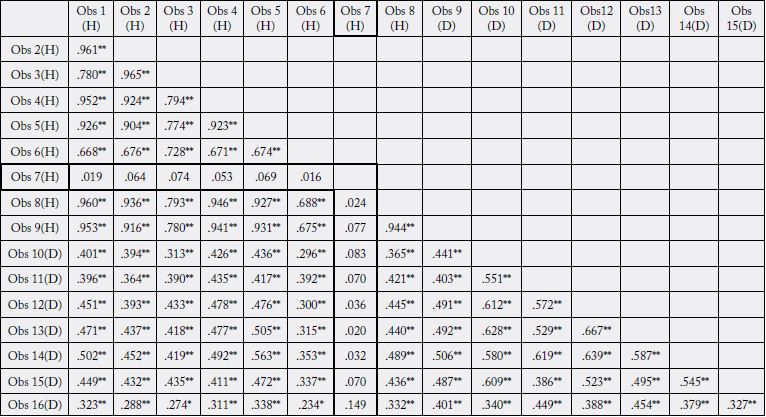
** The correlation is significant at level 0.01 (bilateral)
*The correlation is significant at level 0.05 (bilateral)
The participants privately, individually and anonymously filled out the test and questionnaire in the order
in which the variables were described, only receiving help from the researcher if they had questions or
difficulties.
Results
In the hypothesis “people with higher scores on physical attractiveness have a more favourable attitude
towards infidelity yet are less jealous”, the Pearson’s correlation revealed that there is no correlation in the
first part of the hypothesis between the “Physical attractiveness” variable and the “Jealousy” variable because
the result of the significance is p = 0.227 (Figure 2).
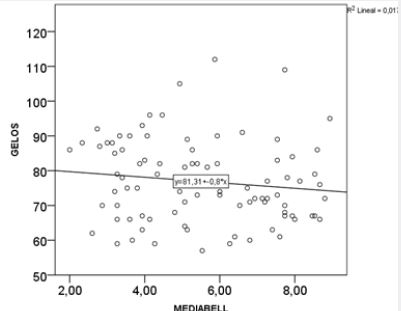
Regarding the second part of the hypothesis, which relates the evaluation referring to “Physical attractiveness” and “Infidelity”, the Student’s t-test shows that there are significant differences in the majority of items (see Table 1).
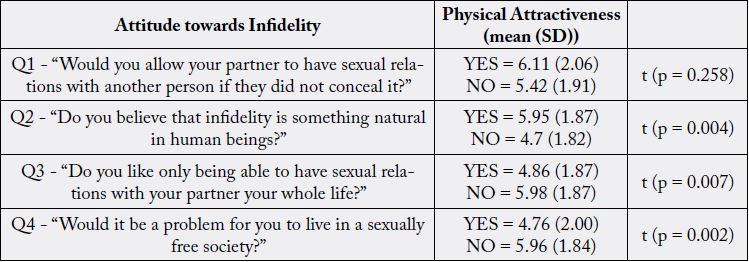
No significant differences were found between the subjects with a higher score on physical attractiveness (mean = 6.11, SD = 2.06) and those who scored lower (mean = 5.42, SD = 1.91) on the first question (Q1), in which they were asked if they would allow their partner to have sexual relations with another person as long as they did not conceal it, t = 1.140; p = 0.258.
We observed that the subjects who regard infidelity as something natural on the second question (Q2) had significantly higher physical attractiveness scores (mean = 5.95, SD = 1.87) than subjects that do not view it as natural (mean= 4.71, SD = 1.82), t = 2.982; p = 0.004. Likewise, the subjects who answered that they do not like the fact that they can only have sexual relations with a single partner their entire life on the third question (Q3) had significantly higher scores on physical attractiveness (mean = 5.98, SD = 1.87) than subjects that said that they did like this (mean = 4.87, SD = 1.87), t = 2.751; p = 0.007. Finally, the subjects who responded that it would not be a problem for them to live in a sexually liberal society on the fourth question (Q4) achieved significantly higher scores on physical attractiveness (mean = 5.96, SD = 1.84) than subjects that said that it would be a problem (mean = 4.76, SD = 2.00), t = 1.706; p = 0.002.
The Student t-test showed that the subjects who answered “yes” that they would like to live in a sexually free
society where sexual variety was not stigmatised had significantly higher scores on physical attractiveness
(mean = 6.35, SD = 1.76) than those who answered “no” (mean = 4.71, SD = 1.77), t = 4.311; p < 0.001.
The Student t-test showed that the subjects with a higher score on physical attractiveness repressed
unfaithfulness due to social pressure. Those who answered “yes” had significantly higher scores on physical
attractiveness (mean = 6.74, SD = 1.71) than those who answered “no” (mean = 4.71, SD = 1.62), t = 5.599;
p < 0.001.
Discussion
These results just described reflect several differences in infidelity and jealousy based on the subjects’ physical
attractiveness. It was shown that more attractive people have a significantly more favourable attitude towards
infidelity that those with lower scores. As Pérez (2006) noted, the likelihood of being unfaithful correlates
with the number of chances the person has to do so. Therefore, the fact that the people who expressed a more
favourable attitude towards infidelity were the more attractive ones reinforces and corroborates the author’s
hypothesis. However, no differences were found regarding jealousy, which means that even though more
attractive people have a more positive attitude towards infidelity, they do not plan to tolerate the jealousy
that their partner may cause, yet nor do they plan to increase it by thinking that they might be the victims
of infidelity. That is, they would agree with living in a sexually free society in which sexual variety outside
the couple were not stigmatised, as noted by the first secondary hypothesis, since having a more favourable
attitude and not feeling more jealousy means sexual freedom for both themselves and their partners.
Despite this, the results show that the people who repress themselves the most from being unfaithful due to social pressure are the most attractive ones. We might think that they are the ones that repress themselves the most because they have the most opportunities to be unfaithful, as Pérez (2006) [12] noted. However, whatever the reason, it makes more sense that they would want to establish a sexually free society without stigmas since social pressure is what hinders them from having the full sexual life that they desire. If a freer society did exist, the concept of “sexual infidelity” would disappear or at least lose many of the negative connotations that society confers on it; therefore, they would not have to repress themselves.
Conclusions and Limitations
When performing this study, we were able to draw conclusions like more attractive people have a significantly
more favourable attitude towards infidelity. In contrast, attractiveness has nothing to do with jealousy. At
the same time, we concluded that more attractive people have a more favourable attitude towards freedom
and sexual variety caused by multiple factors such as the social pressure that represses them from being
unfaithful.
We have striven to be as rigorous and strict as possible; however, the sample is very homogeneous, which means that the results can only be extrapolated to one segment of the population.
Annexe
Multidimensional Jealousy Questionnaire
Code:....................
Sex: M/F Age: ………………
Education/Training: ……………………………………………………………………………………
Marital Status? Single/With Partner/Married/Divorced/Widowed/Other
Totally agree (5)
Agree (4)
Neutral (3)
Disagree (2)
Totally disagree (1)
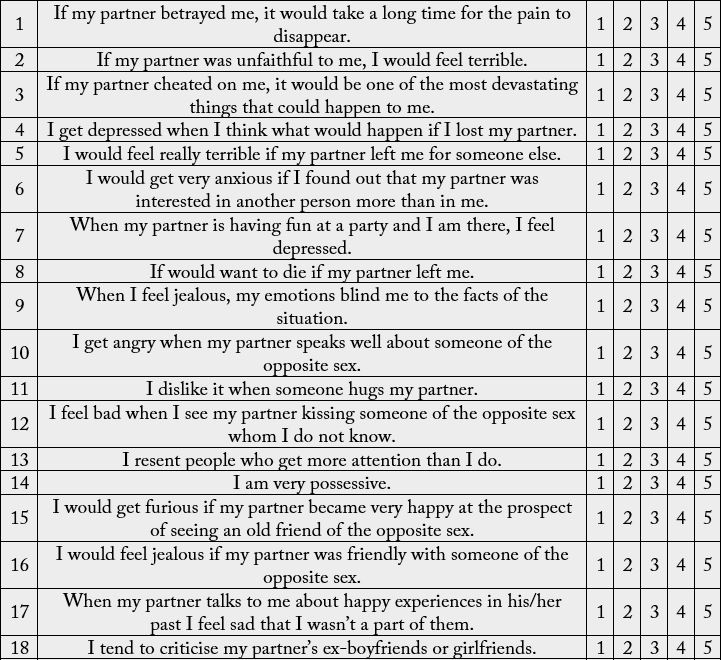
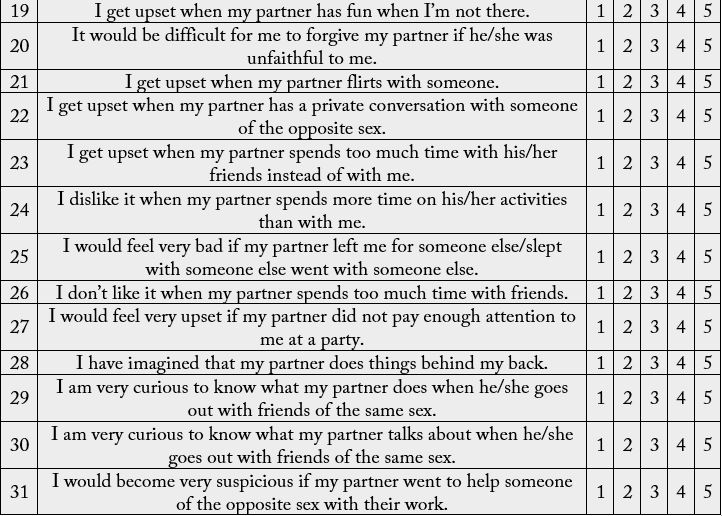
Bibliography

Hi!
We're here to answer your questions!
Send us a message via Whatsapp, and we'll reply the moment we're available!